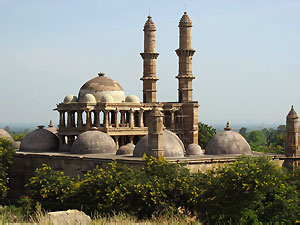|
Champaner, situated
about 47 kms. north east of Vadodara, stands on a 882
m high in the Girnar Hills. Champaner is a UNESCO
World Heritage site, Gujarat's former capital.
Champaner was established as the Chauhan Rajput
capital in the 8th century. It is an ancient fort
located at the foothills of Pavagadh. The walls at the
base of the hill were once 6 kms. long and surround
military, civic and religious buildings and complex
water harvesting systems. The town derives its name
from the Champa tree or from Champaraja, founder of
the town, a contemporary of King Vanraj Chavda of
Anhilwada. The entire landscape is scattered around
with remains of fort walls, ruined tombs, gardens,
arches, |
 |
|
|
History of Champaner
Champaner was established as the Chauhan Rajput capital in
the 8th century. The town derives its name from the Champa
tree or from Champaraja, founder of the town, a contemporary
of King Vanraj Chavda of Anhilwada. The famous Muslim king
of Gujarat, Muhammad Begada captured the fort in the late
15th century after a long siege against the Khichi Chauhan
Rajputs. On a strategic trade route, it was besieged by
Sultan Mahmud Begara, who succeded in taking it in 1484 AD.
The fortress was the old capital of the local Rajputs who
lost it in 1484 to Sultan Mahmud Beghara who renamed it
Muhammadabad. It is said that it took 23 years to build his
new city. Many bazaars, ton squares, royal gardens and water
structures, including mosques were constructed during these
years. I also became a major trading center producing fine
silk, wove and dyed textile and sword manufacturing. Its
decline started after attacks by the Mughal Emperor Humayun
in 1535 AD. In his campaign in Gujarat, the Mughal Emperor
Humayun personally led a small team that scaled the walls of
the city using iron spikes and then let the rest of the army
in through the main gate. After the death of Sultan Bahadur
Shah in 1536 AD, the royal capital was again moved back to
Ahmedabad. With the collapse of the Empire, Champaner passed
to the Mughals, Marathas and British. In 1803 AD, when the
British took the town, it was overgrown with jungles and had
only 500 inhabitants.
Tourist Attractions in Champaner
At Champaner, one can see three fortifications - the base (Champaner),
the top (Pavagadh) and the area connecting both of them (Machi).
The lower fortification is the citadel or the Champaner
fort. The major mosques in Champaner are Shehar ki Masjid,
Jami Masjid, Kewada Masjid and Nagina Masjid. In Kewda
Masjid, you can walk up the narrow stairs to the rooftop,
with the globe like domes, as rounded as fruit and even
further up the minarets for great views. Nearby is the Iteri
Masjid, with brick built minarets that resemble factory
chimneys and even further into the countryside is the Nagina
Masjid, with no minarets but exquisite geometric carving.
The Jami Masjid is intact and is a large, richly ornamented
mosque modelled on the Friday Mosque at Ahmedabad. There are
interesting Gujarati features such as oriel windows.
More...
How to reach Champaner
By Air:
The nearest airport is located at Vadodara, which is about
46 kms.
By Rail:
Champaner is a railway station on Vadodara - Godhara railway
line.
By Road:
Champaner is connected by road with all the major cities of
Gujarat like Ahmedabad and Vadodara. |